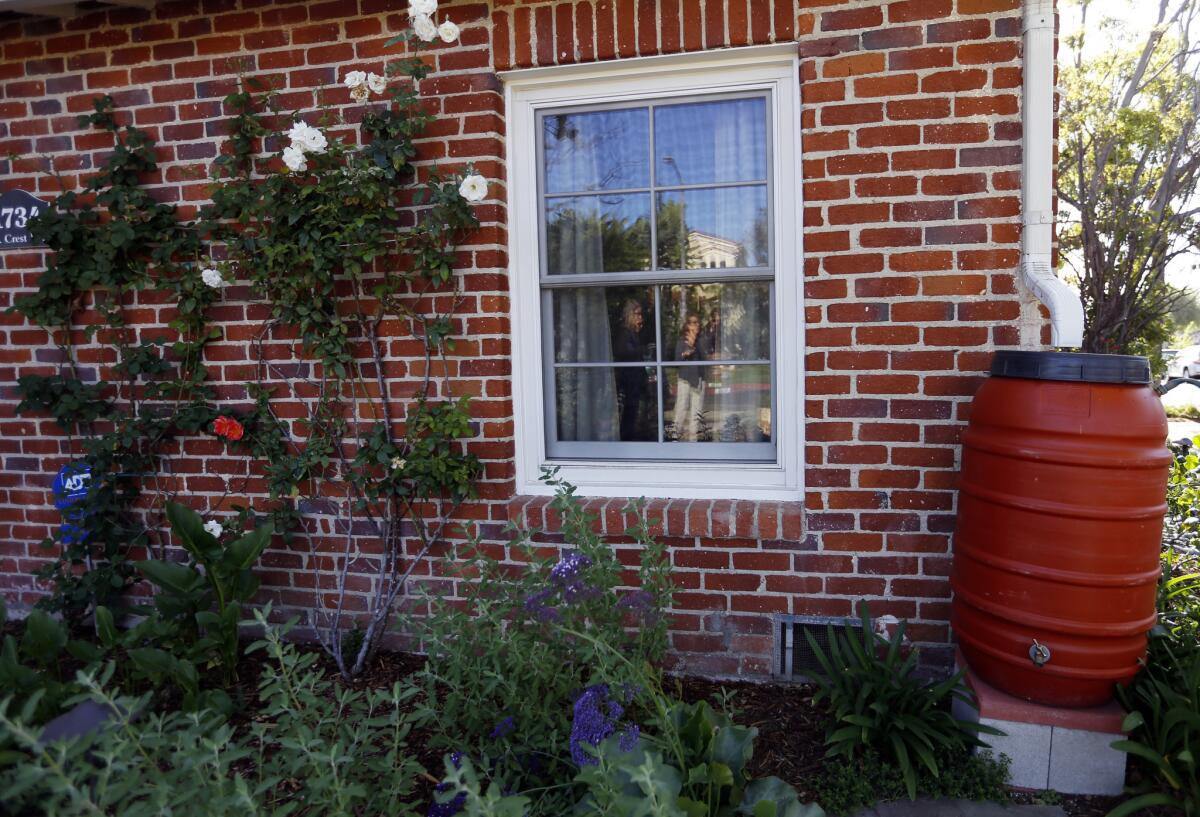From the Archives: Imagine: Rain, rain, stored away

Shop around for rain barrels now, so you’re ready when the rain finally hits. Many cities offer discounts.
While you watched much-needed showers race down the driveway and spill into street drains two weeks ago, did you perhaps think: How can I harness that rainfall? How can I save that water for a yard that has endured drought-like conditions?
It turns out that “harvesting” rainfall is not only good for the garden, but also good for the environment.
And there are several ways you can prepare for the next major storm to keep some of that moisture in your landscape and away from the drainage systems.
Increasingly, homeowners want strategies to capture and retain storm water, whether for irrigating the garden during dry spells or to divert it from gushing down the block.
In response, municipalities such as Santa Monica sponsor grant programs to help residents renovate their properties, and savvy designers offer solutions that are functional and aesthetically pleasing.
Peter Jensen, a landscape designer with Gaudet Design Group of Santa Monica, says rainfall isn’t polluted until it hits the streets. “That’s when it mixes with brake fluid, motor oil and gas spills that are concentrated on pavement, gets swept into the larger drainage systems and eventually spills into the ocean.”
To Jensen, traditional residential landscapes are water wasters. Expansive front lawns require irrigation and boost your water bill. Impermeable driveways shed precipitation into the streets. Downspouts dump water into municipal drainage systems. This waste adds up to thousands of gallons of water that otherwise could remain within the homeowner’s own landscape.
Jensen recently helped John Francis and Susanne Meline capture rainwater in their Santa Monica yard. With the added incentive of a city grant covering half of the project’s $5,000 price tag, the couple worked with Jensen to design a custom water-management system that holds as many as 450 gallons of rainwater. “Depending on the rate that rainwater seeps into the ground, the pit can accommodate more water over an extended time,” Jensen says.
To determine the ideal size and volume of the infiltration pit, Jensen calculated the potential rainfall that his clients’ roof would shed into the yard. The pit, about 200 cubic feet, is a straight-sided hole in the ground, lined with landscaping cloth and filled with variously sized rocks. It is topped off with larger rocks to emulate a dry creek. The system allows water to seep slowly into the ground rather than mixing with pollutants on the city streets. Some designs also have outlets to handle overflow during extreme storms.
In addition to rock-filled infiltration pits, commercial products are available. For example, a system by Australia-based Atlantis Corp. ( www.atlantiscorp.com.au) uses modular cubes fabricated from recycled plastic to filter water underground. “But all pits are still ‘custom dug’ based on the size of the project,” Jensen points out.
Whether the Francis-Meline property receives light mists or heavy rain, any water that hits their roof, combined with excess backyard water, moves through downspouts and is collected in drainpipes leading to the in-ground system. After meandering, stream-like, along the rocks, the water settles in the submerged pit. Some systems use a silt basin to remove debris, although Jensen’s design allows water to run through rock and landscaping fabric, which filters out the silt.
To neighbors who stroll along the sidewalk, the design’s above-ground portion resembles a stone creek bed dotted with rushes, sedges and native ground covers. A 15% grade change from the front door to the sidewalk puts gravity to work as water flows downhill. “I tried to make this look like a natural system using the topography of the yard with plants that grow along riverbeds,” he says.
Other water-capturing techniques enhance the landscape. Jensen shattered a large section of the two-car driveway and reconstructed it with ground covers and ornamental grasses. Silvery mats of Dymondia margaretae, a spreading perennial that can handle foot traffic, are knit together with flowering thyme between sections of concrete. Raindrops soak into the planted areas rather than wash down to the street. The front walkway uses a similar approach, recycling leftover broken concrete for steps rather than being sent to the landfill.
Where a traditional turf-style front lawn once stood, Jensen planted no-mow lawn, a grass that requires less water and eliminates use of an energy-hogging lawn mower. The parking strip is planted with a flowering evergreen yarrow, a good lawn substitute.
To irrigate the garden during dry times, Jensen installed a state-of-the-art drip system. Instead of operating on a timer, it is linked to an Internet weather site that calculates the property’s water needs, turning on during dry spells and off when it rains.
Hugels, swales offer DIY rainwater catchment options
Jensen adopted many of the same techniques in Sandi and Joe Lee’s property, also in Santa Monica. Their redesign transformed a grassy front lawn, a straight walkway and formal rose hedges into a modern, low-water-use scheme.
A new asymmetrical path of separated landings allows for better drainage. The infiltration system is topped with warm-hued river rock, and the garden is planted with geometric blocks of Agave americana ‘Mediopicta Alba’, rosy Echeveria ‘Afterglow’ as well as native deer grass (Muhlenbergia rigens).
“We could have hidden the infiltration pit underground and planted over the top,” Jensen acknowledges. “But I wanted to uncover it to show how it works in a natural system for channeling water.
“As more people do small things to save water, they will build up to be major things -- and help the environment.”


